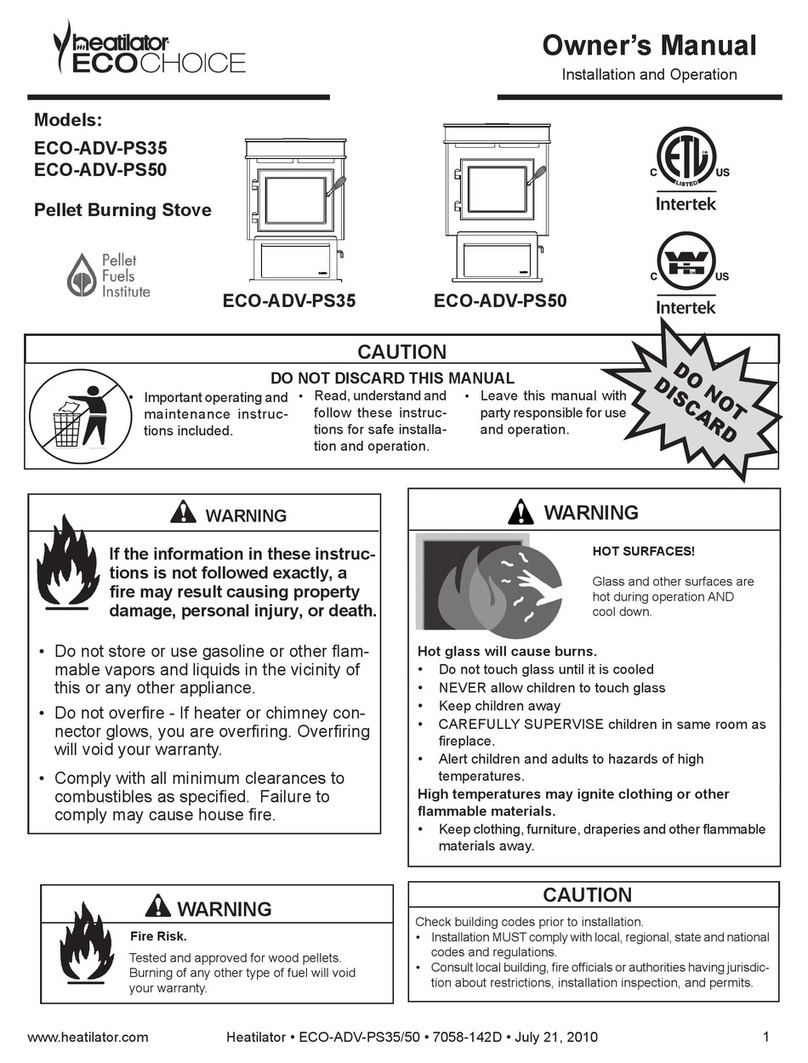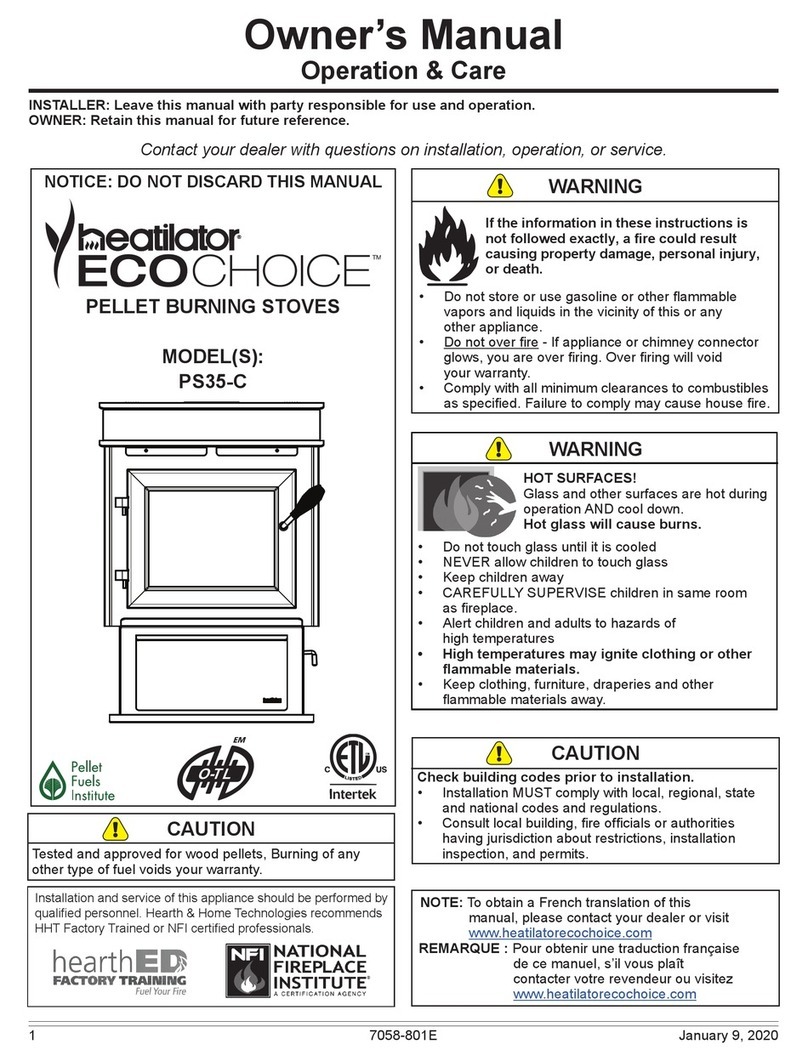C# 4001508
Manufactured by: Fabriqué par:
352 Mountain House Road
Halifax, Pa 17032
www.heatilatorchoice.com
CAB50-C
Serial No.
N° de série HF
0061PS085E
CAUTION:
HOT WHILE IN OPERATION DO NOT TOUCH, KEEP CHILDREN AND
CLOTHING AWAY. CONTACT MAY CAUSE SKIN BURNS.
CHAUD LORS DE L'OPÉRATION. NE PAS TOUCHER. GARDEZ LES ENFANTS ET LES VÊTEMENTS
LOIN DE L'ESPACE DÉSIGNÉ DE L'INSTALLATION. LE CONTACT PEUT CAUSER
DES BRÛLURES À LA PEAU. GARDEZ LES MEUBLES ET LES MATÉRIAUX COMBUSTIBLES LOIN DE
L'ESPACE DÉSIGNÉ DE L'APPAREIL. VOIR L'ÉTIQUETTE ET LES INSTRUCTIONS.
ATTENTION:
KEEP FURNISHINGS AND OTHER COMBUSTIBLE MATERIAL FAR AWAY FROM
THE APPLIANCE. SEE NAMEPLATE AND INSTRUCTIONS
*
Non-combustible floor protection must extend 2 inches (51mm) beneath
the flue pipe when installed with horizontal venting or under the Top Vent
Adapter with vertical installation. RECOMMENDED IN USA; REQUIRED
IN CANADA.
*Un protecteur incombustible de plancher doit s'étendre 2 inches (51mm) sous le
conduit de cheminée pour une installation de ventilation horizontale ou sous un
adapteur de ventilation de dessus pour une installation verticale.
ÉTATS-UNIS -
RECOMMANDÉ; CANADA - REQUIRENT.
Floor protector must be non-combustible material, extending beneath
heater and to the front/sides/rear as indicated. Measure front distance (I)
from the surface of the glass door.
Le poêle doit être placé sur une assise non combustible s’étendant tout autour de lui,
comme les schémas l’indiquent. Mesurez la distance du devant (I) de la surface de
la porte vitrée.
FLOOR PROTECTION / PROTECTION DU SOL
NOTE 1:
In residential installations, when using Parts TPVNT-5, (3" - 3" Top Vent Adapter) and
812-3570 (3" - 6" Offset Adapter), 24 gauge 6" single wall flue connector may be used.
NOTE 1: Dans les installations résidentielles, lorsque les pièces TPVNT-5, (dessus de l'adapteur
de ventilation 3" - 3") et 812-3570 (le ressaut de l'adapteur 3" - 6"), un tuyau connecteur de 6" pour
mur simple de calibre 24 peut être utilisé.
NOTE 2: In manufactured home installation, when using Part TPVNT-5, (3" - 3" Top Vent Adapter)
and 812-3570 (3" - 6" Offset Adapter), use listed double wall flue connector. An Outside Air Kit
(Part 811-0872), must be used with manufactured home installation.
NOTE 2: Pour l'installation dans les maisons préfabriquées, lorsque les pièces TPVNT-5, (dessus
de l'adapteur de ventilation 3" - 3") et 812-3570 (le ressaut de l'adapteur 3" - 6"), utilisez un tuyau
connecteur enregistré pour mur double. Un assemblage d'air extérieur (Part 811-0872), doit être
utilisé pour l'installation dans les maisons préfabriquées.
A Back Wall / Mur Arrière 2 in [51mm]
B Side Wall / Mur De Côté 14 in [356mm]
CORNER INSTALLATION / NSTALLATION DU COIN :
C Side Wall / Mur De Côté 2 in [51mm]
VERTICAL 3 in. - 3 in. ADAPTER KIT (PART TPVNT-5) INSTALLATION:
UN ASSEMBLAGE POUR ADAPTEUR 3- 3 in (76-76mm) (PIÈCE TPVNT-5) POUR INSTALLATION VERTICALE:
D Pipe to Back Wall / Un Tuyau Mur Arrière 1 in [25mm]
E Side Wall / Mur De Côté 14 in [356mm]
F Back Wall / Mur Arrière 6.25 in [159mm]
CORNER INSTALLATION WITH VERTICAL ADAPTER KIT:
INSTALLATION DU COIN AVEC UN ASSEMBLAGE D'ADAPTEUR VERTICAL
:
G Side Wall / Mur De Côté 2 in [51mm]
ALCOVE INSTALLATION /
INSTALLATION DE L' ALCÔVE
:
Min. Alcove Height: /
Une hauteur minimum de l'alcôve
56.75 in [
1441mm]
Min. Alcove Side Wall: /
Une hauteur minimum m
ur de côté
de l'alcôve
14 in [356mm]
Min. Alcove Width /
Une épaisseur
minimum m
ur de côté
de l'alcôve
53 in [1346mm]
Max. Alcove Depth: /
La profondeur maximum de l'alcôve
48 in [1219mm]
Max. Mantle Depth: /
Profondeur maximum de la manteau de cheminée 36 in [914mm]
Top of Unit to Combustibles: / Vue du haut des matériaux combustibles 21 in [533mm]
Listed Solid Fuel Room Heater/Pellet Type.
Also suitable for Mobile Home Installation. This
appliance has been tested and listed for use in Manufactured Homes in accordance with OAR
814-23-9000 through 814-23-909.
Certified to ASTM STD E1509, Certified to ULC STD S627, ULC/ORD-C1482-M1990 Room Heating
Pellet BurningType, (UM) 84-HUD FOR USE
ONLY WITH PELLETIZED WOOD.
Do not use any other
type of fuel. Intertek-Test Laboratories has determined that this appliance complies with Canadian
Standards Association (CSA) B415.1 and Title 40 of the U.S. Code of Federal Regulations, Part 60,
SubPart AAA.
Input Rating: 49,869 Btu's/hr. Electrical Rating: 115 VAC, 60 Hz, Start 5.1 Amps, Run 3.0 AMPS.
Route power cord away from unit. Do not route cord under or in front of appliance. Do not obstruct the
space beneath the heater.
DANGER:
Risk of electrical shock. Disconnect power supply before servicing. Replace glass only with
5mm ceramic available from your dealer. To start, set thermostat above room temperature, the stove will
light automatically. To shutdown, set thermostat to below room temperature. For further instruction refer
to owner's manual.
Keep viewing and ash removal doors tightly closed during operation.
PRÉVENTION DES FEUX DE MAISON
I
nstallez et utilisez en accord avec les instructions d'installation et d'opération du fabricant. Contactez le bureau de la
construction ou le bureau des incendies au sujet des restrictions et des inspections d'installation dans votre voisinage. Ne pas
obstruez l'espace en dessous de l'appareil.
A
VIS - Pour Les Maisons Mobiles: Ne pas installer dans une chambre à coucher. Un tuyau extérieur de combustion d'air doit
être installé et ne doit pas être obstrué lorsque l'appareil est en usage. La structure intégrale du plancher, du plafond et des
murs de la maison mobile doit être
maintenue intacte.
Référez vous aux instructions du fabricant et des codes locaux pour les précautions requises pour passer une cheminée à
travers un mur ou un plafond combustibles, et les compensations maximums.
Inspectez et nettoyez la cheminée fréquemment. Ne pas connecter cet appareil à une cheminée servant un autre appareil.
Utilisez systèm de ventilation "L" ou "P" diamètre 76mm ou 102mm
Testé à: ASTM E1509-04, ULC S627-00, ULC/ORD-C1482-M1990 Room Heating. Pellet Burning Type, (UM) 84-HUD
POUR USAGE AVEC LES BOULETTES DE BOIS. N’utiliser aucun autre genre de combustible.
Intertek Test
Laboratories a déterminé que cet appareil se conforme avec la norme de l’Association Canadienne de normalisation
(CSA) B415.1 ainsi que le Titre 40 du Code Fédéral de Régulations des États-Unis, partie 60, sous-partie AAA.
Puissance de Rendement: 49,869 Btu's/hr. Puissance Électrique: 115 VAC, 60 Hz, Début 5.1 Amps, Courir 3.0 Amps,
Éloignez le fil électrique de l'appareil. Ne pas faire passer le fil électrique au dessus ou en dessous de l'appareil. Ne pas bloquer
l’espace au dessous de l’appareil.
DANGER: Il y a risque de décharge électrique. Déconnectez le fil électrique de la prise de contact avant le service.
Remplacez la vitre seulement avec une vitre céramique de 5 mm disponible chez votre fournisseur.
Pour allumer, monter la température du thermostat au dessus de la température de la pièce, le poêle s'allumera automatiquement.
Pour éteindre, descendre la température du thermostat en dessous de la température de la pièce. Pour des instructions
supplémentaires, référez vous au manuel du propriétaire. Gardez la porte d'ouverture et la porte des cendres fermées
hermétiquement durant l'opération.
Appareil de chauffage de combustible solide/de type de boulettes.
Accepté dans l'installation dans les maisons mobiles. Cet appareil a été testé et enregistré pour l'usage dans les
Maisons Mobiles en accord avec OAR 814-23-9000 jusqu'à 814-23-909.
PREVENT HOUSE FIRES
Install and use only in accordance with manufacturer's installation and operating instructions. Contact local
building or fire officials about restrictions and inspection in our area.
WARNING - FOR MOBILE HOMES: Do not install appliance in a sleeping room. An outside
combustion air inlet must be provided. The structural integrity of the mobile home floor, ceiling and walls
must be maintained.
Refer to manufacturer's instructions and local codes for precautions required for passing chimney
through a combustible wall or ceiling. Inspect and clean vent system frequently in accordance with
manufacturer's instructions.
DO NOT CONNECT THIS UNIT TO A CHIMNEY SERVING ANOTHER APPLIANCE.
Use a 3" or 4" diameter type "L" or "PL" venting system.
Refer to the Intertek Directory of Building Products (https://bpdirectory.intertek.com) for detailed information.
Reportez-vous au répertoire des produits de construction d'Intertek (https://bpdirectory.intertek.com) pour obtenir des informations détaillées.
A. Sample of Serial Number / Safety Label



































